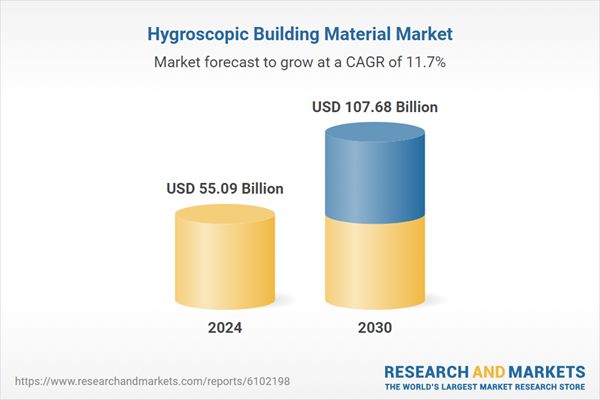Speak directly to the analyst to clarify any post sales queries you may have.
10% Free customizationThis report comes with 10% free customization, enabling you to add data that meets your specific business needs.
Their integration into modern construction aligns with sustainable design trends, enhancing thermal performance and supporting eco-friendly practices. As demand for healthier, more energy-efficient buildings grows globally - driven by regulations and green certification requirements - hygroscopic materials are gaining traction among developers, architects, and engineers. Their applications span both new construction and renovation, across residential, commercial, and institutional sectors.
Key Market Drivers
Growing Demand for Energy-Efficient and Passive Buildings
The increasing emphasis on energy-efficient and passive building design is a key driver accelerating growth in the hygroscopic building material market. With stricter energy regulations and rising sustainability benchmarks, the construction sector is under pressure to reduce environmental impact. Hygroscopic materials contribute significantly by passively regulating indoor humidity - absorbing and releasing moisture in response to atmospheric conditions - thereby reducing reliance on mechanical HVAC systems. This leads to lower energy consumption and supports compliance with green building certifications such as LEED, BREEAM, and WELL. Consequently, architects, builders, and developers are turning to materials like clay, lime, wood, and hempcrete for their dual benefits of performance and sustainability. These materials not only improve thermal comfort but also provide long-term operational cost savings, aligning with the growing preference for eco-conscious construction practices.Key Market Challenges
Limited Consumer Awareness and Market Education
A major barrier to the widespread adoption of hygroscopic building materials is the limited awareness and understanding among consumers, construction professionals, and architects regarding their benefits and functionality. Despite their proven ability to regulate indoor air quality and enhance occupant comfort, hygroscopic materials remain underutilized due to insufficient market education.Many stakeholders default to traditional building materials, which are more familiar, accessible, and appear cost-effective in the short term. The long-term advantages of energy savings and health improvements are often overlooked or inadequately communicated. Additionally, construction education and professional training programs seldom cover hygroscopic material science in depth, leading to a knowledge gap that hinders their inclusion in design and planning stages. This challenge is particularly pronounced in developing regions, where awareness of sustainable practices is still emerging and price sensitivity tends to outweigh environmental considerations.
Key Market Trends
Integration of Hygroscopic Materials in Sustainable and Green Building Practices
A significant trend in the hygroscopic building material market is their growing integration into environmentally sustainable building practices. As energy-efficient construction becomes a priority worldwide, materials like wood, clay plasters, lime-based products, and natural fibers are being incorporated into green building designs. These materials offer passive moisture regulation, improving indoor air quality and reducing the burden on HVAC systems. Their use aligns well with certifications like LEED and BREEAM, making them increasingly attractive to builders and architects focused on sustainable development. By enhancing thermal stability and humidity buffering, hygroscopic materials help create healthier and more energy-efficient indoor environments. This trend is further supported by innovations in eco-friendly construction techniques and a growing consumer demand for buildings that promote well-being and environmental responsibility.Key Market Players
- Compagnie de Saint-Gobain S.A.
- Rockwool A/S
- Knauf Insulation GmbH
- Owens Corning
- BASF SE
- Kingspan Group plc
- Gutex Holzfaserplattenwerk H. Henselmann GmbH & Co. KG
- Thermo-Hanf Vertriebs GmbH
- Havelock Wool LLC
- Soprema S.A.S.
Report Scope:
In this report, the Global Hygroscopic Building Material Market has been segmented into the following categories, in addition to the industry trends which have also been detailed below:Hygroscopic Building Material Market, By Material Type:
- Silica Gel
- Activated Clay
- Zeolites
- Natural Fibers
- Synthetic Fibers
Hygroscopic Building Material Market, By Application:
- Moisture Control in Indoor Environments
- Humidity Regulation in Libraries & Museums
- Packaging & Storage
- Food & Pharmaceutical Industry
- Electronics & Automotive Industry
Hygroscopic Building Material Market, By Form:
- Desiccant Bags & Cartridges
- Desiccant Packets
- Desiccant Panels & Sheets
- Desiccant Beads
- Desiccant Powders
Hygroscopic Building Material Market, By Region:
- North America
- United States
- Canada
- Mexico
- Europe
- France
- United Kingdom
- Italy
- Germany
- Spain
- Asia-Pacific
- China
- India
- Japan
- Australia
- South Korea
- South America
- Brazil
- Argentina
- Colombia
- Middle East & Africa
- South Africa
- Saudi Arabia
- UAE
- Kuwait
- Turkey
Competitive Landscape
Company Profiles: Detailed analysis of the major companies present in the Global Hygroscopic Building Material Market.Available Customizations:
With the given market data, the publisher offers customizations according to a company's specific needs. The following customization options are available for the report.Company Information
- Detailed analysis and profiling of additional Market players (up to five).
This product will be delivered within 1-3 business days.
Table of Contents
Companies Mentioned
- Compagnie de Saint-Gobain S.A.
- Rockwool A/S
- Knauf Insulation GmbH
- Owens Corning
- BASF SE
- Kingspan Group plc
- Gutex Holzfaserplattenwerk H. Henselmann GmbH & Co. KG
- Thermo-Hanf Vertriebs GmbH
- Havelock Wool LLC
- Soprema S.A.S.
Table Information
| Report Attribute | Details |
|---|---|
| No. of Pages | 180 |
| Published | June 2025 |
| Forecast Period | 2024 - 2030 |
| Estimated Market Value ( USD | $ 55.09 Billion |
| Forecasted Market Value ( USD | $ 107.68 Billion |
| Compound Annual Growth Rate | 11.6% |
| Regions Covered | Global |
| No. of Companies Mentioned | 10 |









